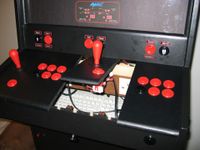Modular Control Panels
A modular control panel is a panel that is divided into sections such that individual sections, some as small as a single joystick, can be swapped out or rearranged to form different control panel layouts. This differs from Swappable Control Panels where the entire panel is typically removed. The most flexible modular systems even allow variable width panels - typically from 2" to 16" wide to accomodate different size controls. Wiring for each control typically goes to a patch panel and interface card or USB hub for analog controls.
The main advantage of a modular control panel is the ability to play virtually any game given a minimal set of unique controls. Rather than duplicating controls on several different swappable panels you can simply move your existing control modules around to form the layout you need for a given game. In addition, it avoids the frankenpanel syndrome, since you can have 20 or more different types of controls but only install the ones that are needed as they are needed.
The challenges involved for a modular system include precise cutting and alignment of the panels, designing a mechanical system to secure the panels while still making them easy to change, and coming up with innovative artwork given that the panels might be assembled in random order. In addition, wiring can be a challenge, though several modular designers have settled on a fairly simple wiring design based on CAT5 ethernet patch panels and connectors. The CAT5 connectors each have 8 wires which is enough for 7 control lines and a ground to drive any joystick or 7 button panel. See Doc's Modular Mame for an example of this type of wiring. Analog devices typically are interfaced with a USB mouse hack to a USB hub installed under the control panel.
